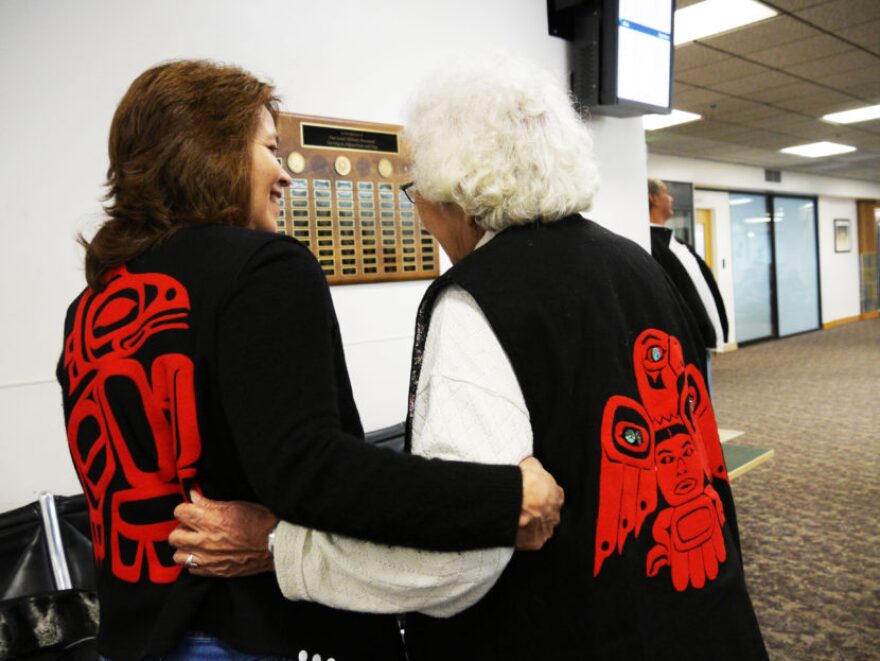Hundreds of people gathered Thursday at Glacier Bay National Park and Preserve to celebrate the opening of a newly completed Huna Tribal House and the National Park Service’s 100th anniversary.
Not everyone could make it. Some event speakers and tribal members were stuck at Juneau International Airport because of fog near the park. But that didn’t stop them from watching the event from afar.
Two decades in the making, the Xunaa Shuká Hít, which roughly translates to Huna Ancestor’s House, celebrates the four major Huna Tlingit clans that lived in the area that became Glacier Bay National Park and Preserve. According to the park service, villagers fled an advancing glacier hundreds of years ago. Clan members couldn’t return to area because it was taken over by the National Park Service in the 1980s.
But as the fog cleared Thursday morning, and tribal members paddled to the shore in newly carved canoes, Glacier Bay called its people back to their homeland.
Planes traveling TO the area weren’t able to land. This left about a dozen people unable to attend.
Republican U.S. Sen. Lisa Murkowksi was one of them.
“We are sitting here waiting for the fog to lift in Gustavus, along with a fair number of Alaskans who are hoping to go out, to be part of the celebration,” Murkowski said.
She was hoping to catch a late morning flight, but it didn’t work out. At that point, the terminal’s only television was tuned to live coverage of the event.
The last time Murkowski was in Gustavus was in 2012. Officials were trying to break ground for the tribal house.
“I saw the details and the plans, so I was really looking forward to being able to see it ‘live and in color,’ as they say. So maybe we’ll yet get out there today, but it remains to be seen,” Murkowski said.
Across the lobby, Bert Frost is sitting with a couple of his colleagues. He’s the regional director for the National Park Service in Alaska. He says it’s an important part of American history -- and this event emphasizes that Alaska Native history is a part of that.
“A lot of people don’t understand that there’s a Native tie to those lands, it wasn’t just created in 1917," Frost said. "This is the homeland for the Huna Tlingit.”
He hopes that the tribal house will help rebuild the relationship between the tribal community and the National Park Service.
“We always haven’t had a great relationship and the Native people," Frost said. "So through this effort of building this tribal house and the things it represents to the Huna Tlingit and the NPS, is the coming together for all of these entities.”
Adrienne Fleek also works for the park service, as the Alaska Native liaison.
“There’s a really big commonality between the mission of our organization ... with the Alaska Native way of being, of preserving and protecting our resources for the seven generations to come,” Fleek said.
She’s planning to meet up with family at the ceremony and is dressed for the occasion.
“I have a traditional Tlingit vest on, on the back it is a Raven emblem and on the front is Coho," Fleek said. "Traditionally when you go to a ceremony, you wear regalia to show who your family is.”
And she wasn’t the only one sporting regalia.
Around the corner, Lilian Austin is watching a livestream of the event. She’s wearing a traditional black vest, with her tribe’s Thunderbird stitched on the back -- one of the four big clans from Glacier Bay.
“It’s pretty good that building there," Austin said. "It took them five years to do this building, it’s got all of the different clans’ designs, ours is Kaagwaantaan.”
Austin is a tribal elder who grew up in Hoonah, and spent summers in Glacier Bay as a child. Her nephew, Herb Sheakley, is one of the carvers for the project.
As of Thursday afternoon, she was still waiting for reliable transportation to the event.
“I’m looking forward to it, I got up early for it, still sitting here," Austin laughed. "I got up early for it.”
She says, like everyone else in limbo at the airport, she’s excited she hasn’t seen the tribal house either.
If weather permits, it’ll be the first time she’s visited Glacier Bay in more than 50 years.


